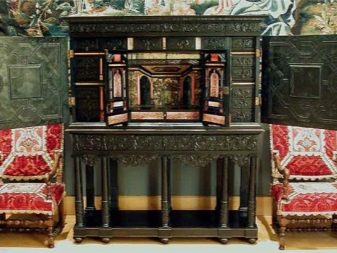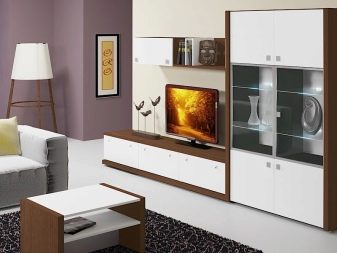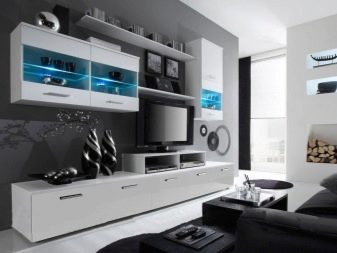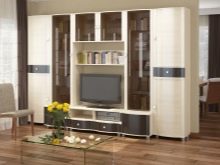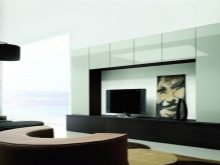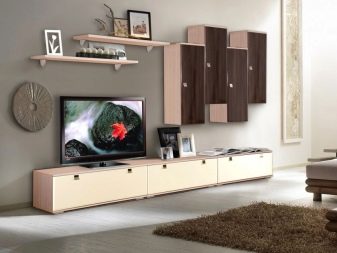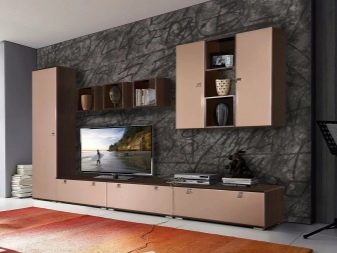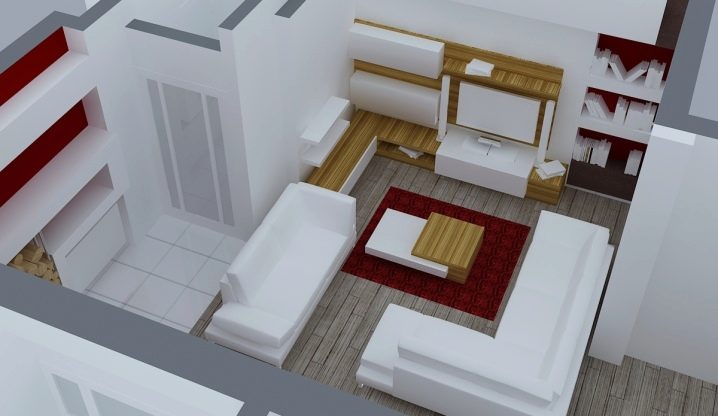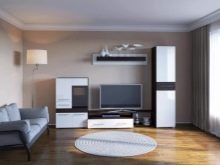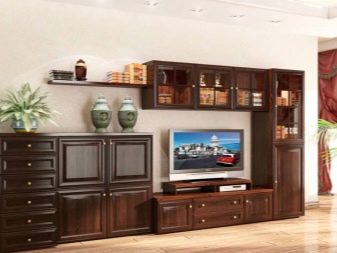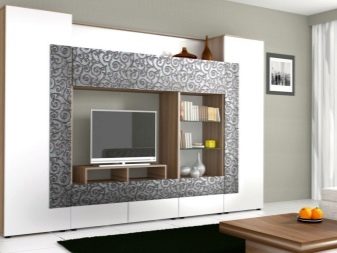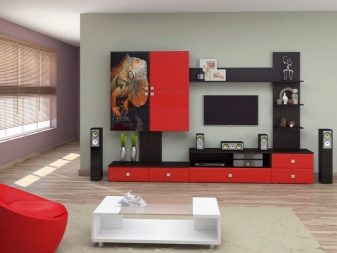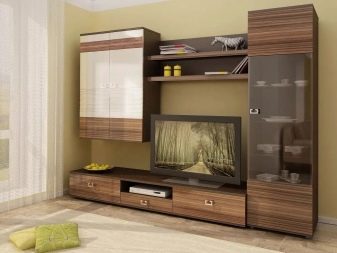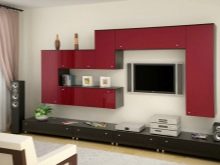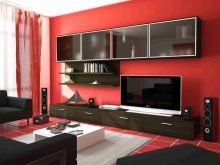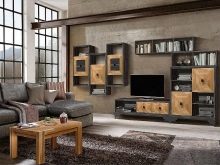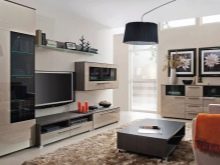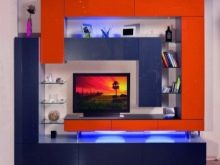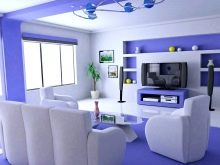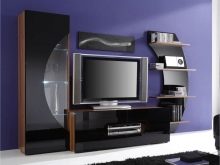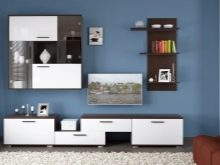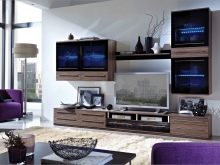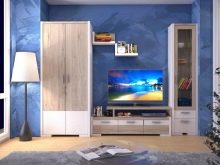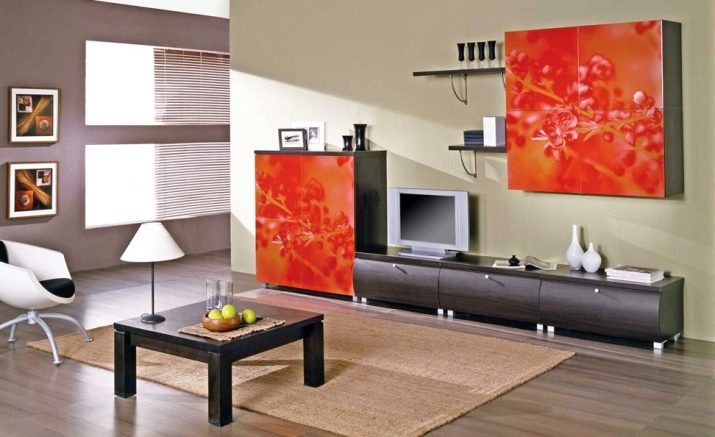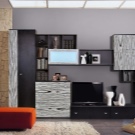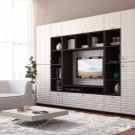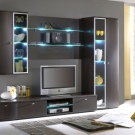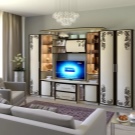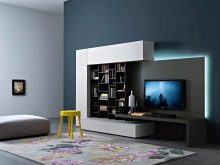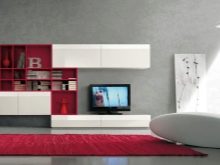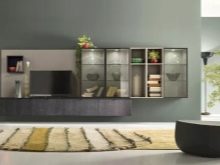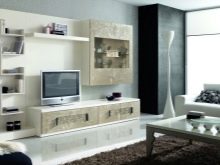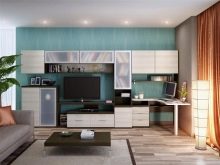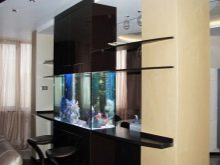Modern modular walls in the living room
Furniture wall as part of the interior furnishing was invented in France in the middle of the 20th century. It is to the French designer that we owe a comfortable furniture composition, which allows us not to wrestle with the choice of parts separately, combining styles, materials and decor. Furniture walls became popular all over the world, and in the Soviet Union they were considered an indicator of respectability and comfort, because they saved space, and their glass sideboards with beautiful dishes served as decoration for any living room.
With the arrival of the XXI century, bulky furniture walls of past times were replaced by more elegant modular wall-slides, smaller in size, which are not rectangular cabinets in the whole wall, but a set of furniture of different heights.
Special features
Currently, the peak of popularity is kept by modular walls consisting of objects of different sizes and not limited to a single body. Modular can be both assembled into a single harmonious wall, and located in different places. Moreover, the objects in such walls can be interchanged, rearranged and outweighed, each time updating the design of the room.
Species
Between themselves, modular walls can vary in size, configuration and purpose, to contain in their composition the most different number of objects.
- Standard wall is a composition of cabinets and drawers, located in a straight line along the wall.
- U-shaped wall option implies free space in the middle of the structure, suitable for living rooms where it is planned to put, for example, a desk. U-shaped walls can also have in free space a panel for installing equipment: a TV, speakers, computer monitor.
- L-shaped walls presupposes the presence of one high wardrobe with the side of the structure and the hanging shelves, pedestals and supports for equipment, which diverge from it.Such models look lightweight and easy.
- Corner models will look great in a room where you need to use the corner. The middle of such a wall can accommodate the space for a TV or desktop. The doors of cabinets and pedestals will open freely without interfering with each other. The corner wall can also include bookshelves diverging on the sides of the table, on the sides ending with one or two cabinets on either side.
- Suspended wall presupposes independent furniture elements attached to the wall. As a rule, these are small lockers, shelves, racks. For cabinets and their filling must take into account the strength of the wall.
Whichever modular wall option you choose, it is worth remembering that it is completely universal and can be arranged at your discretion.
Dimensions
The furniture models offered in the manufacturers' catalogs have a range of standard sizes. Models differ in three main parameters: height, width of furniture and depth of shelves. But, as a rule, furniture factories are willingly engaged in the manufacture of furniture to order, so making furniture according to an individual non-standard size will not be difficult.
The dimensions of the wall are crucial when choosing this type of furniture.The wall should be conveniently placed in the living room, fit into the interior style without cluttering it. Too voluminous wall in a small living room will create a feeling of tightness and will hide the look of other interior items. Too small or narrow will be useless in terms of functionality or “lost” in a spacious hall.
Before making a choice in favor of a particular model, it is necessary to make a project of the room, make measurements of the future location of the modular wall.
Many manufacturers offer a 3D design service, where on the computer screen you can see the placement of furniture in the room, making the program the appropriate size and design.
Materials
A variety of modular walls is a huge selection of options, from the most expensive to quite budget. Modern technologies make it possible to create furniture from various materials in such a way that the output of economy-class structures does not suffer their quality and appearance.
Tree
Traditionally, furniture walls are made from different types of wood. Items made of expensive species of oak, cherry and mahogany look solid and aesthetically pleasing,they are the most durable and durable, fit perfectly into the classic interior, emphasizing the taste and respectability of the owner. However, this is not the most suitable option for modular wall models. Furniture from solid wood canvases is quite heavy, it is inconvenient to rearrange, not to mention the fact that not every wall can withstand the weight of hanging elements.
Chipboard and MDF
A more economical option, made from small wood chips using adhesive resin. Chipboard coated with laminated film of various colors and shades, have a presentable appearance and excellent performance properties. This material is light, and with quality manufacturing it is difficult to distinguish it from natural wood furniture.
Combined models
Modern furniture production allows you to successfully combine a variety of materials in the production of modular walls. Along with a natural tree and wood plates, plastic, glass and metal are actively used. This allows you to make furniture affordable, easier, practical and very modern. Most of the most popular models include a chipboard or MDF frame, and a facade made of noble wood.
Decorative materials
Decorative decoration plays a decisive role in the choice of any furniture, so modern designers do not stint on the manifestation of imagination in the manufacture of modular walls and sets. Glass and mirror components are most often used for the facade of doors and shelves. Recently, the design of the facades of the wall with materials from textiles, glossy plastic, and artificial leather is gaining in popularity. Acrylic and film coatings of bright colors with prints enliven the interiors as well as paintings and photo wallpapers.
Metal
Metal parts serve as decoration and fittings, and can also be a frame and edging of furniture. Chrome handles of objects, stands and bars, transitions between elements of furniture are the main characteristic features of modern high-tech style. And forged and copper decor elements, legs and gilded inserts add the noble features of furniture in the style of classicism, art deco. The artificially aged metal will emphasize the grace of tender Provence and retro styles. And the steel luster of the deliberately coarse armature will add color to the street-production loft style or the natural rustic style.
Colors
The most popular when choosing a modular wall in the living room are the colors of neutral shades. The color range of natural wood is able to bring a touch of comfort and convenience into all interior styles, with the exception, perhaps, of the modern ultra-high-tech style. The tree perfectly harmonizes and enlivens the atmosphere with style classic directions.
Modern designers are not limited to "wood" palette. In the interiors are increasingly given preference to bright colors of glossy surfaces in a wide variety of colors.
When choosing a color, it is necessary to take into account a few simple rules so that the interior looks harmonious and the furniture is pleasing to the eye and complements the overall style of the living room:
- furniture wall should be combined in color or with wall decoration, or with the rest of the furniture. In this case, the objects of the module will not become an alien color spot in the general “choir” of the interior;
- if the room is decorated in a certain style, then the colors must match it. Screaming neon shades are not suitable for the classic living room, and for the high-tech style, gold paint and deep shades of noble wood are alien;
- the color scheme should not tire the eye, create the effect of "overhanging" furniture over everything else. For small rooms, it is preferable to choose light (milky or beige) shades, they visually expand the space. For spacious rooms, you can choose dark stylish furniture, but in the presence of a light shade of wall cladding.
Design
When thinking about the design of the modular wall in the interior of the living room, it is important to consider its size and location relative to other objects. Too voluminous modular elements can look great in a spacious living room, but for a small room they are not suitable. The best option for a modular wall will be one in which all the elements you need are present.
Most often it is a wardrobe, a cabinet for equipment, hanging lockers for small things and dishes, shelves for books. Some design options involve open or glazed windows - they add elegance and airiness to the interior. If necessary, modular elements can be transferred to other rooms, for example, a wardrobe in the bedroom, and a sideboard for dishes in the kitchen.This option is applicable only if the kitchen or bedroom is combined with the living room or are in the same style.
In a small living room, it would be good to look as open as possible with light hanging cabinets, miniature drawers, and a TV panel. It can be arranged in any direction along the wall, slide or zigzag.
For spacious rooms, high volume wardrobes are relevant, as well as a multitude of objects that can be both combined into a single structure and distributed around the walls of the room. This may be a dining area with a glazed sideboard and a mini-bar or a working area with a sliding table and a section for computer equipment, shelves for books, as well as a seating area with side tables and a panel for video and audio.
Accordingly, the selection of furniture in the modular wall will cost less than the purchase of items separately, and the furniture itself will be designed in the same style and design.
Equally important in interior design is the decoration of the facade of the modules. Depending on the style direction elements of the decor can serve:
- chrome or forged cabinet handles;
- carving on the facade of wooden objects;
- photo printing with bright prints;
- sandblast drawings on the surface of mirrored doors;
- built-in lights for glass or mosaic inlays on the facade.
Style decisions
If the living room initially has a certain style direction, then it will not be difficult to choose the corresponding modular wall to it. In the case, if you are just deciding on the style, you should understand them in more detail and proceed from the general rules when choosing a wall. We note the main characteristics that may have furniture modules for a particular style.
Classic. As a rule, it is massive furniture of the correct proportions from noble breeds of a tree. Its color is distinguished by calm noble tones, most often it is white, beige, milky. Dark gamma - cherry, mahogany, wenge. Décor of carvings, forged handles, curved gilded monograms is welcomed. Glass and crystal will add lightness and solemnity to the design.
Minimalism. Modern style, suggesting convenience and functionality. The wall in this style will consist of the minimum quantity of the most necessary objects.The lack of lush decor and auxiliary details is the main feature of minimalism. The style is characterized by the presence of several lockers, panels for modern technology, simple and convenient wardrobes, light racks. The coloring, on the contrary, can be bright, glossy.
High tech. Ultrastyle for fans of the latest technology and technological progress. Furniture modules resemble abstract figures aboard an alien ship. The main materials are plastic, metal, glass. The wooden case of the wall is leveled or covered with dark paint and varnish compounds. Cold colors, colors in black and white, steel range will complement the urban style of modern times. Bright splashes of neon colors are also welcome.
Country The style has many directions, but its main unifying feature is the cozy atmosphere of a wooden house in the countryside. Materials from wood predominate, and in the decor - natural shades, natural patterns or artificially aged wood, forged fittings.
Art Deco. Mirror things, unusual shapes, chess combinations of colors give this style and brilliance to this style.Furniture in the art deco style can be from dark expensive wood, chrome-plated inserts, mirror mosaic. All kinds of lights will create a play of light and complement the living room with an atmosphere of luxury and celebration.
Selection rules
First, decide where the wall modules will be located, how much space they will occupy, what items are needed. This will allow weed out unsuitable options in a huge number of proposed models.
Considering the product catalogs, pay attention to the style, material and color of the finished products. It should correspond either to the already existing decor of the interior, or fit into the planned style.
Check out the quality features. They depend on both the material and the manufacturer. When buying, check the availability of all parts, the strength of fasteners, stability of the structure
Require a quality certificate or passport of the product where you can check the composition of the material and the presence of the necessary components, especially in the case of prefabricated furniture wall.
Beautiful options
- The aesthetic type of products in the hall, everyone chooses to his taste,But of the most attractive models, you can recommend new furniture with a mini-bar or glass cabinets for works of art, sports awards, collectibles.
- Corner walls with a built-in writing desk zoning the living room to a study and a recreation area look original. In one part of the wall, you can place the modules under the equipment, while the other part of the composition will create a convenient place to work.
- In modern living rooms, the aquarium built into the furniture wall looks very original, its neon lighting and bright lively colors give the living room a special charm.
An interesting version of the modular wall for the living room, see the following video.

